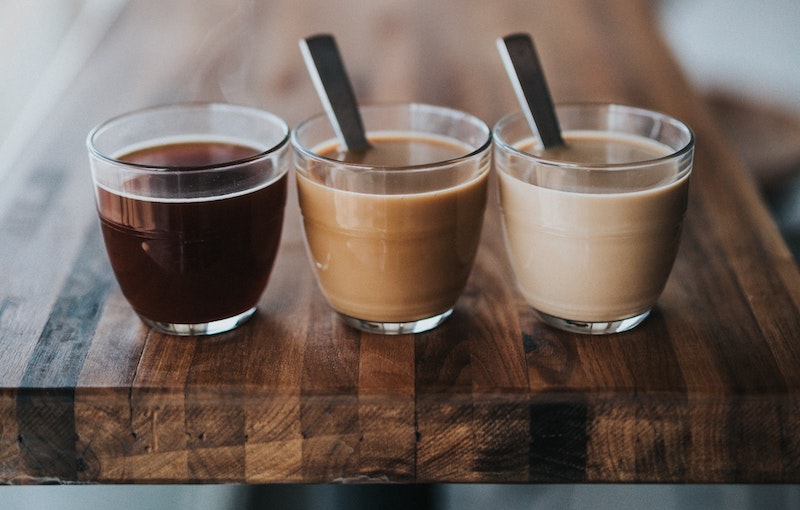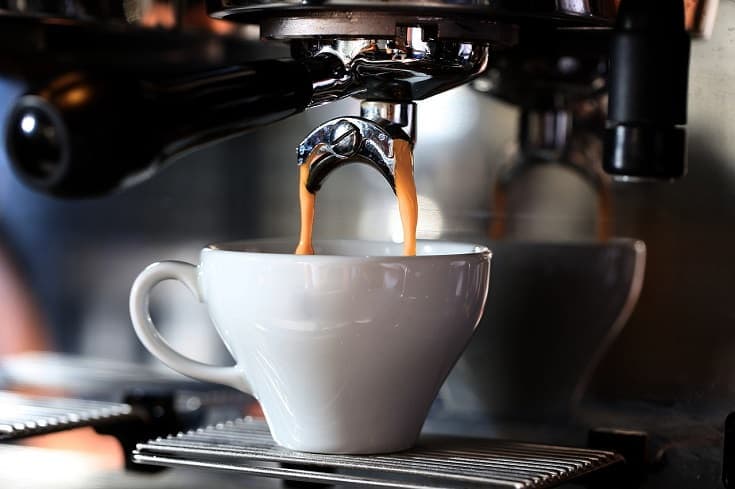
Have you ever wanted to drink espresso at a trendy coffee house, but you were too self-conscious to work up the nerve to order one? Somewhere along the line, drinking espresso became linked to trendy New Yorkers and artsy college students. It took on a nerve-racking persona of its own that intimidates many coffee-minded people.
If you have ever felt like this or you want to impress the next barista you come in contact with, we are here to tell you that ordering the tasty brew doesn’t have to be a “naked in front of the crowd” scenario. With a few tips and a little know-how, you’ll be able to walk into any coffee house with confidence.
In the article below, we will outline the proper way to order and drink an espresso. We’ll also share the few differences between the “modern” way of drinking it versus the “old-school” Italian method.

Understanding Espresso: Learn the Lingo
Before you walk into a coffee house, you want to familiarize yourself with barista jargon. Knowing the lingo allows you to order exactly what you are looking for, plus it helps you feel more confident if the barista throws an unexpected question at you.
Espresso
If you’ve found this article, we bet you already know what an espresso is. We are not talking about the strict definition here, though, but rather the pronunciation. There is nothing more likely to induce eye-rolling from the person across the counter than an expresso order.
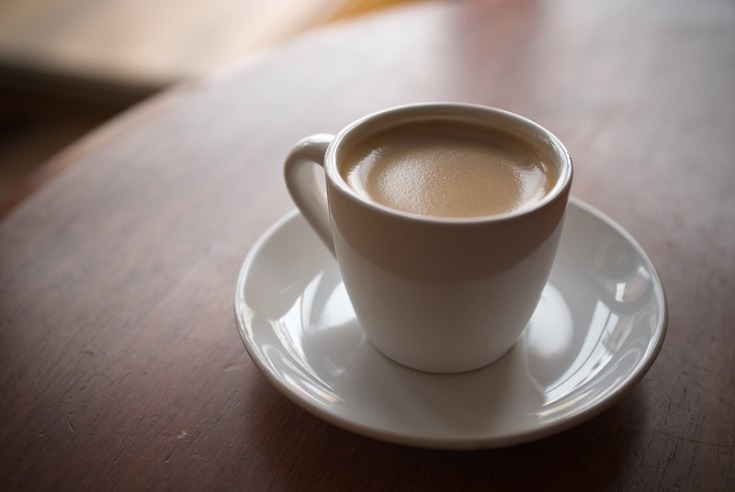
As is the case with most mispronounced words, the best thing to do is look at it phonetically—(eh-spress-o). Also, important to note: that espresso is both a noun and a verb. Meaning that it’s used as the name of the brew and the method in which it’s made.
Shot
A shot is another word for espresso. That being said, it is typically used to describe beverages that contain espresso plus other ingredients. Some examples of this would be a cappuccino, macchiato, or mocha latte.
You may also be asked whether you want a single or double shot. Just as it sounds, a single shot is one espresso and a double shot is two espressos.
Demitasse
Pronounced dem-e-tas, this is the cup your espresso should come in. Traditionally, espresso is made in a small white ceramic mug/cup. The word demitasse is French for half a cup, though why an Italian beverage is served in a French named cup is still a mystery.
In reputable coffee houses, an espresso order will automatically come in such a mug. If you want to impress someone or show off your knowledge, however, you can order an espresso in a demitasse to garner a little extra java envy.
Pull an Espresso
This term was used to describe the process of making espresso back when espresso machines used nine bars of pressure to force hot water through coffee grinds. During this time, the barista would manually pull levers to make the coffee, thus the phrase “pull an espresso” was coined.
Nowadays, most coffee houses use modern machines that don’t require levers. That being said, the phrase is still commonly used. For example, you might hear something like, “Be careful, espresso that is freshly pulled is very hot!”

Dial In
Dial-in refers to the process of regulating and tweaking the brewing method. This could mean changing the size of the grinds, increasing the temperature of the water, or refining the pressure. Regardless, dialing in means the coffee is being perfected as much as possible.
Crema
This next term is an important one. Crema refers to the white, foamy-like substance that sits on top of your espresso when it’s first pulled. It is a by-product of CO2.

In an espresso machine, CO2 creates tiny air bubbles. When they come in contact with oils from the coffee grinds, a foam-like substance appears. This is also known as the “Guinness effect” as it’s essentially the same thing as getting a “head of foam” on top of your beer.
Crema can tell you a lot about your espresso, and there are various opinions on how to consume it; we will discuss this in more detail later.
Cupping
Cupping is a technical process used by coffee farmers to taste and rate their harvest. It’s an intricate quality check system for their beans. Be that as it may, a lot of non-farmers use the term to describe the less complicated and in-depth method of tasting espresso to find the different flavor notes in the brew.
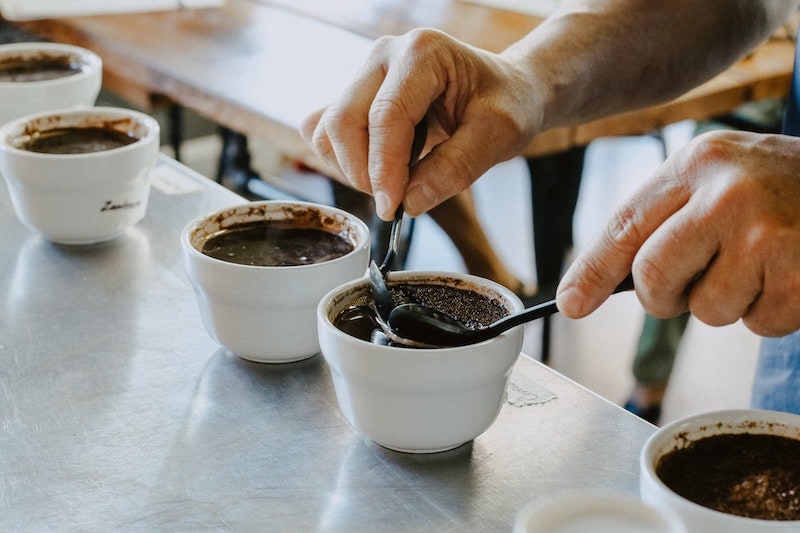
Along the same theme, you may also hear the terms over-extracting and under-extracting to describe the flavor of a particular coffee. In general, over-extracting means the coffee is bitter while under-extracting means it has a sour taste.
Mouthfeel
Similar to cupping, mouthfeel is how the brew “feels” in your mouth. It can describe everything from texture, flavor, weight, acidity, oiliness, and much more. As you acquire the taste for espresso and become more fine-tuned to the individual flavors, you will be able to describe the mouthfeel more accurately.

How to Drink An Espresso Properly In 5 Easy Steps
Okay, now that you have the lingo down, it’s time to jump into the actual drinking of the beverage. Espresso consumption can vary depending on where you are and who you ask. That being said, we have broken down how to enjoy espresso into five steps. We have provided the most common methods, plus the more traditional aspects. This way, you will be fully prepared to enter any coffee house you desire.
1. Ordering an Espresso
Once inside a cafe, the first order of business is giving the barista your order. To get the full scope, you want to order the shot “for here” to enjoy in-house. You also have the option of ordering a single or double shot. We recommend getting a double unless you have already tried out a few other coffee houses that day. A double will give you a more complete experience.
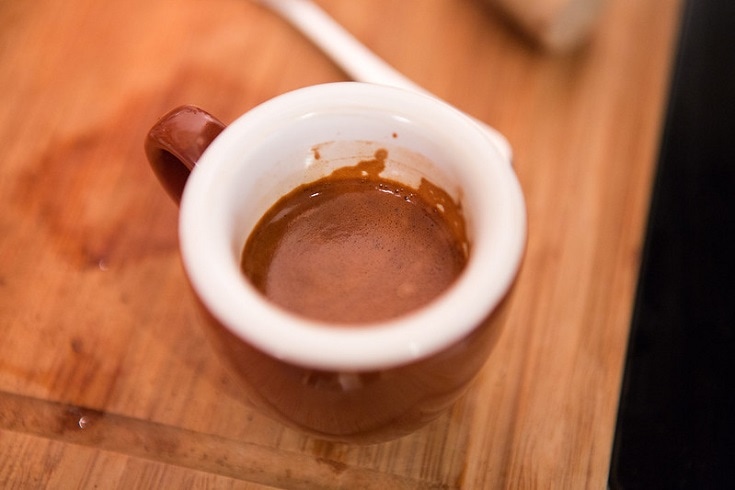
Where you sit can also make a difference depending on where you are. For example, many people like to take a seat at a table, especially if they plan to order food. Traditionally, though, espresso is meant to be consumed quickly and jovially. This means taking a seat (or standing) at the bar, sparking up a chat with your neighbor, and being on your way within 10 to 15 minutes.
Finally, don’t forget to mention you prefer your shot in a demitasse!
2. Cleansing Your Palate
This next step is often where the newbie espresso drinker gets confused. Once you have placed your order, the barista may or may not return with a bottle (or glass) of sparkling water—it depends on the location. This won’t happen at Starbucks, mind you. However, the traditional method is to cleanse your palate and open up your taste buds before drinking your brew. This will allow you to fully experience the flavors and notes of the coffee.
Sparkling water is served as the effervescence stimulates your taste nodes and opens them up. Not only that, but it will wash away any other leftover flavors that may be hiding. An individual coffee bean can have more than 1,000 flavors, so you want to be ready to taste as many as possible.
3. The Crema
Once your espresso arrives, you want to take a minute to inspect it. If it was just pulled (hopefully), you should have a layer of crema on top that can tell you a lot about the coffee within. Ideally, the crema should have a thick consistency and be a dark reddish color. This means the beans your coffee was made with are those of quality.
The crema also helps hold in the aroma; which you want to sample before drinking, as well. As we mentioned above, the crema gives you a lot of insight into your beverage. Coffee aficionados spend hours having spirited discussions about the consistency, smell, color, meaning, and taste of this by-product. Many believe that it’s the window into the soul of the espresso, so examining carefully is important.

Removing the Crema
Once you have gazed into the depths of the crema, it’s time to get rid of it. Seriously, it’s gross! This is where things get tricky, though, as there are varying opinions on this. In general, most “modern coffee experts” believe it’s better to use your spoon to scrape off the crema. It’s very bitter tasting, and doing so doesn’t remove anything from the actual coffee flavor. Those on this side of the crema insist that it is perfectly acceptable and good espresso drinking procedure.
Leaving the Crema
On the other hand, “traditional coffee house experts” would never dream of removing the crema. It is part of the shot and part of the experience. They also believe it holds most of the aroma which is half the flavor. Removing it means you are not drinking it the traditional way.
What do we think? Try it both ways. Chances are, no one will bat an eye if you remove it, but you also want to experience the taste of it, as well. What both sides do agree upon is that you need to decide whether to remove it quickly. Crema will start to sink to the bottom fairly quickly, which is what you don’t want to happen.
4. Stir
This is another aspect of drinking espresso that is a contention point with many experts. Do you stir or not stir? Again, the old-school way of drinking espresso is to leave it be and drink it as is. On this point, though, we recommend giving it a quick mix.
Espresso tends to separate after brewing. The heavier syrup-like parts sink to the bottom while the brighter notes float to the top. Swirling the spoon a few times will ensure that both elements of the drink are distributed evenly, giving it a well-balanced flavor.
For the sake of giving all the information, those who don’t like to stir don’t do so because they want to taste the separate parts of the coffee. The difference in flavor from the first sip to the last creates an overall experience. If you are new to espresso, we suggest making use of the spoon, however. It can take time to acquire the taste for the different notes.
5. Drinking Espresso
It’s finally time to drink your espresso. Like the steps above, though, there is some deliberation about the correct way to do this. In our opinion, the way you drink it is directly related to your desired experience. Do you drink espresso for a quick pick me up (which is the more traditional view), or are you interested in finding the flavors, notes, and consuming it more for the experience?

This is an important question to ask yourself, and the answer may change from day to day. In Italian cafes, people drink their espresso while standing at the counter and chatting with other customers. They never stir, typically drink the crema, and take it down in one or two quick sips—before it gets too cool.
If you are in it to experience the coffee itself, you will likely linger over the beverage a bit more. You will want to sip it more slowly, though it still shouldn’t take you more than four sips. You should also scrape off the crema, and stir it. If this is your aim, your first taste should be just enough to cover your tongue so you can pick out the different notes and flavors. Same with the second, third, and last sips.

Tips for Drinking Espresso
If you truly want to impress, we have a few more tips that will help you navigate the espresso scene.
Keep these things in mind as they will help you not only be more confident but help you get the most out of the experience.
- Acquired Taste: Drinking espresso is not only a bit intimidating for some, but it’s also a romanticized activity. Wanting to be the suave and chic person at the cafe counter can quickly sour after the first strong sip. Espresso can be an acquired taste, especially if your normal go-to drink is a Dunkin’s caramel iced coffee. It may take time for your palette to appreciate the subtle notes and bold flavor, but the more you do it the better it will be.
- Knowing a Good Espresso: Going off of the tip above, if you are not used to drinking them, you may not be able to tell an average espresso from a great one. Quality espresso should be bitter but not too bitter. It should also have a rich flavor, but not to the point of being overpowering. The mouthfeel should be total, substantial, but not leaving you gasping for breath or reaching for a water glass. There should also be lighter (bright) notes usually as the after taste.
- When to Drink Espresso: Most coffee lovers will drink espresso at any point during the day. To drink it like a traditional Italian, however, there are some time restraints. In Italy, people drink espresso in the afternoon. The strong black shot gives a boost during the afternoon slump. They also don’t drink coffee with milk after 11:00 AM, and especially not after meals.
- Other Forms of Espresso: Unless it is a drip coffee selection, most items you order from a coffee house start with a shot of espresso. Cappuccinos, lattes, etc., all have a single or double-shot base, but the final result is no longer an espresso. That being said, there are some variations of the espresso itself:
- Macchiato: Unlike what you find at Starbucks, a true macchiato is an espresso with a mark (splash) of milk.
- Americano: This is a good order if you are trying to get used to the bold flavor of straight espresso. The Americano is a shot with more hot water added than the traditional cup.
- Cafe Lungo: This is between an Espresso and an Americano as it has more hot water than the former but less than the latter.
- Corretto: This is typically an evening beverage as the shot of espresso is diluted with alcohol. Translating to “corrected coffee,” most people use either grappa or sambuca.

The Bottom Line
We hope you have enjoyed this tutorial on how to order, drink, and enjoy an espresso. While it can be a bit intimidating to order your first shot at a trendy coffee shop, like anything else, practice makes perfect.
There is also something to be said for singing (or in this case sipping) to your tune. If you like espresso at midnight with a Big Mac, by all means! To get the full experience, though, it’s good to know the basics along with a few tips…which we hope we have given you today!
Featured Image: sonerkose, Pixabay






